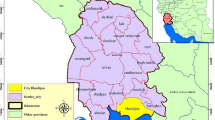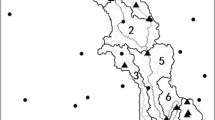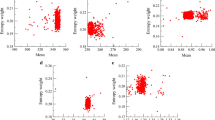Abstract
Sensitivity analysis is an important component for modelling water resource and environmental processes. Analysis of Variance (ANOVA), has been widely used for global sensitivity analysis for various models. However, the applicability of ANOVA is restricted by this biased variance estimator. To address this issue, the subsampling based ANOVA method are developed in this study, in which multiple subsampling(single-, multiple- and full-subsampling) techniques are proposed to diminish the effect of the biased variance estimator of ANOVA. Two case studies including one simplified regression model and one hydrological model are used to illustrate the applicability of the proposed approaches. Results indicate that: (1) the subsampling procedures effectively diminish the biases resulting from traditional ANOVA method; (2) among the proposed subsampling approaches, the full-subsampling ANOVA has the most robust performance; (3) compared with Sobol’s method, the subsampling ANOVA methods can significantly reduce the calculation requirements while achieve similar sensitivity characterization for model parameters. This study serves as a first basis for the application of subsampling ANOVA methods to sensitivity analysis for water resource and environmental models.





Similar content being viewed by others
References
Bahremand A, De Smedt F (2008) Distributed hydrological modeling and sensitivity analysis in Torysa watershed. Slovakia Water Resour Manag 22:393–408
Bennett KE, Urrego Blanco JR, Jonko A, Bohn TJ, Atchley A, Urban NM, Middleton R (2018) Global sensitivity of simulated water balance indicators under future climate change in the Colorado Basin. Water Resour Res 54(1):132–149
Borgonovo E, Plischke E (2016) Sensitivity analysis: a review of recent advances. Eur J Oper Res 248:869–887
Bosshard T, Carambia M, Goergen K, Kotlarski S, Krahe P, Zappa M, Schär C (2013) Quantifying uncertainty sources in an ensemble of hydrological climate-impact projections. Water Resour Res 49:1523–1536. https://doi.org/10.1029/2011wr011533
Chen X, MolinaCristóbal A, Guenov MD, Riaz A (2019) Efficient method for variance-based sensitivity analysis. Reliab Eng Syst Saf 181:97–115. https://doi.org/10.1016/j.ress.2018.06.016
Chowdhury K (2019) Supervised machine learning and heuristic algorithms for outlier detection in irregular spatiotemporal datasets. J Environ Inform 33:1–16. https://doi.org/10.3808/jei.201700375
Dessai S, Hulme M (2007) Assessing the robustness of adaptation decisions to climate change uncertainties: a case study on water resources management in the East of England. Glob Environ Chang 17:59–72
Đukić V, Radić Z (2016) Sensitivity analysis of a physically based distributed model. Water Resour Manag 30:1669–1684
Fan YR, Huang GH, Baetz BW, Li YP, Huang K, Li Z, Chen X, Xiong LH (2016) Parameter Uncertainty and Temporal Dynamics of Sensitivity for Hydrologic Models: a Hybrid Sequential Data Assimilation and Probabilistic Collocation Method. Environ Model Softw 86:30–49. https://doi.org/10.1016/j.envsoft.2016.09.012
Fan YR, Huang GH, Li YP, Baetz BW, Huang K (2020) Uncertainty Characterization and Partition in Multivariate Risk Inference: A Factorial Bayesian Copula Framework. Environ Res 183:109215. https://doi.org/10.1016/j.envres.2020.109215
Fan YR, Huang K, Huang GH, Li Y, Wang F (2019) An uncertainty partition approach for inferring interactive hydrologic risks. Hydrol Earth Syst Sci Discuss 1–58. https://doi.org/10.5194/hess-2019-434
Gamerith V, Neumann MB, Muschalla D (2013) Applying global sensitivity analysis to the modelling of flow and water quality in sewers. Water Res 47:4600–4611. https://doi.org/10.1016/j.watres.2013.04.054
Giuntoli I, Vidal JP, Prudhomme C, Hannah DM (2015) Future hydrological extremes: the uncertainty from multiple global climate and global hydrological models. Earth Syst Dyn 6:267–285
Hamby DM (1995) A comparison of sensitivity analysis techniques. Health Phys 68:195–204
Herman JD, Kollat JB, Reed PM, Wagener T (2013) Technical note: method of Morris effectively reduces the computational demands of global sensitivity analysis for distributed watershed models. Hydrol Earth Syst Sci 17:2893–2903. https://doi.org/10.5194/hess-17-2893-2013
Hipel KW, McLeod AI (1994) Time series modelling of water resources and environmental systems, vol 45. Elsevier, New York
Khaiter P, Erechtchoukova M (2019) Conceptualizing an environmental software modeling framework for sustainable management using UML. J Environ Inform 34:123–138. https://doi.org/10.3808/jei.201800400
Khorashadi Zadeh F, Nossent J, Sarrazin F, Pianosi F, van Griensven A, Wagener T, Bauwens W (2017) Comparison of variance-based and moment-independent global sensitivity analysis approaches by application to the SWAT model. Environ Model Softw 91:210–222. https://doi.org/10.1016/j.envsoft.2017.02.001
Li Z et al (2015) Development of a stepwise-clustered hydrological inference model. J Hydrol Eng 20:04015008
Lindenschmidt K, Rokaya P (2019) A stochastic hydraulic modelling approach to determining the probable maximum staging of ice-jam floods. J Environ Inform 34:45–54. https://doi.org/10.3808/jei.201900416
Liu Y, Chaubey I, Bowling LC, Bralts VF, Engel BA (2016) Sensitivity and uncertainty analysis of the L-THIA-LID 2.1 model. Water Resour Manag 30:4927–4949
Maqsood I, Huang GH, Huang YF, Chen B (2005) ITOM: an interval-parameter two-stage optimization model for stochastic planning of water resources systems. Stoch Env Res Risk A 19(2):125–133
Morris MD (1991) Factorial sampling plans for preliminary computational experiments. Technometrics 33:161–174
Nash JE, Sutcliffe JV (1970) River flow forecasting through conceptual models part I – a discussion of principles. J Hydrol 10:282–290
Oladyshkin S, De Barros F, Nowak W (2012) Global sensitivity analysis: a flexible and efficient framework with an example from stochastic hydrogeology. Adv Water Resour 37:10–22
Oudin L, Perrin C, Mathevet T, Andréassian V, Michel C (2006) Impact of biased and randomly corrupted inputs on the efficiency and the parameters of watershed models. J Hydrol 320:62–83. https://doi.org/10.1016/j.jhydrol.2005.07.016
Pappenberger F, Beven KJ, Ratto M, Matgen P (2008) Multi-method global sensitivity analysis of flood inundation models. Adv Water Resour 31:1–14
Perrin C, Michel C, Andréassian V (2003) Improvement of a parsimonious model for streamflow simulation. J Hydrol 279:275–289. https://doi.org/10.1016/s0022-1694(03)00225-7
Pianosi F, Beven K, Freer J, Hall JW, Rougier J, Stephenson DB, Wagener T (2016) Sensitivity analysis of environmental models: a systematic review with practical workflow. Environ Model Softw 79:214–232. https://doi.org/10.1016/j.envsoft.2016.02.008
Qi W, Zhang C, Fu G, Sweetapple C, Zhou H (2016a) Evaluation of global fine-resolution precipitation products and their uncertainty quantification in ensemble discharge simulations. Hydrol Earth Syst Sci 20:903–920. https://doi.org/10.5194/hess-20-903-2016
Qi W, Zhang C, Fu G, Zhou H (2016b) Imprecise probabilistic estimation of design floods with epistemic uncertainties. Water Resour Res 52(6):4823–4844. https://doi.org/10.1002/2015WR017663
Qi W, Zhang C, Fu G, Zhou H (2016c) Quantifying dynamic sensitivity of optimization algorithm parameters to improve hydrological model calibration. J Hydrol 533:213–223. https://doi.org/10.1016/j.jhydrol.2015.11.052
Saltelli A, Annoni P, Azzini I, Campolongo F, Ratto M, Tarantola S (2010) Variance based sensitivity analysis of model output. Design and estimator for the total sensitivity index. Comput Phys Commun 181:259–270. https://doi.org/10.1016/j.cpc.2009.09.018
Saltelli A et al (2019) Why so many published sensitivity analyses are false: a systematic review of sensitivity analysis practices. Environ Model Softw 114:29–39. https://doi.org/10.1016/j.envsoft.2019.01.012
Shin M, Guillaume JHA, Croke BFW, Jakeman AJ (2013) Addressing ten questions about conceptual rainfall–runoff models with global sensitivity analyses in R. J Hydrol 503:135–152. https://doi.org/10.1016/j.jhydrol.2013.08.047
Sobol’ BIM (1993) Sensitivity estimates for nonlinear mathematical models. Math Model Comput Exp 1(4):407–414
Tang T, Reed P, Wagener T, Van Werkhoven K (2006) Comparing sensitivity analysis methods to advance lumped watershed model identification and evaluation. Hydrol Earth Syst Sci Discuss 3:3333–3395
Tang Y, Reed PM, Wagener T, van Werkhoven K (2008) Comparison of parameter sensitivity analysis methods for lumped watershed model. In: World environmental and water resources Congress 2008: Ahupua’A, pp 1–8. American Society of Civil Engineers. Honolulu, Hawaii. https://doi.org/10.1061/40976(316)612
Tao Z et al (2011) Estimation of carbon sinks in chemical weathering in a humid subtropical mountainous basin. Chin Sci Bull 56:3774–3782. https://doi.org/10.1007/s11434-010-4318-6
Tian W (2013) A review of sensitivity analysis methods in building energy analysis. Renew Sust Energ Rev 20:411–419
Tsakiris G (1982) A method for applying crop sensitivity factors in irrigation scheduling. Agric Water Manag 5:335–343
Tsakiris G, Spiliotis M (2017) Uncertainty in the analysis of urban water supply and distribution systems. J Hydroinformatics 19:823–837
Uusitalo L, Lehikoinen A, Helle I, Myrberg K (2015) An overview of methods to evaluate uncertainty of deterministic models in decision support. Environ Model Softw 63:24–31. https://doi.org/10.1016/j.envsoft.2014.09.017
Vega M, Pardo R, Barrado E, Debán L (1998) Assessment of seasonal and polluting effects on the quality of river water by exploratory data analysis. Water Res 32:3581–3592
Vitale D, Bilancia M, Papale D (2019) A multiple imputation strategy for eddy covariance data. J Environ Inform 34:68–87. https://doi.org/10.3808/jei.201800391
Wang S, Ancell BC, Huang GH, Baetz BW (2018) Improving robustness of hydrologic ensemble predictions through probabilistic pre- and Postprocessing in sequential data assimilation. Water Resour Res 54(3): 2129–2151. https://doi.org/10.1002/2018WR022546
Weng SQ, Huang GH, Li YP (2010) An integrated scenario-based multi-criteria decision support system for water resources management and planning–A case study in the Haihe River Basin. Expert Syst Appl 37(12):8242–8254
Wu SM, Huang GH, Guo HC (1997) An interactive inexact-fuzzy approach for multiobjective planning of water resource systems. Water Sci Technol 36(5):235–242
Wu H, Chen B, Snelgrove K, Lye LM (2019) Quantification of uncertainty propagation effects during statistical downscaling of precipitation and temperature to hydrological modeling. J Environ Inform 34:139–148. https://doi.org/10.3808/jei.201600347
Xu L, Li G, Mays LW (2001) Optimal operation of soil aquifer treatment systems considering parameter uncertainty. Water Resour Manag 15:123–147
Zhang Z, Zhang Q, Singh VP, Shi P (2018) River flow modelling: comparison of performance and evaluation of uncertainty using data-driven models and conceptual hydrological model. Stoch Env Res Risk A 32:2667–2682
Acknowledgements
This research was supported by the National Key Research and Development Plan (2016YFC0502800, 2016YFA0601502), the Natural Sciences Foundation (51520105013, 51679087), and the Natural Science and Engineering Research Council of Canada. All information used in this research is available in the Hydrological Data of Pearl River Basin, Annual Hydrology Report.
Author information
Authors and Affiliations
Corresponding author
Ethics declarations
Conflict of Interest
The authors have no conflict of interest to declare.
Data Availability Statement
The data that support the findings of this study are available from the corresponding author upon reasonable request.
Additional information
Publisher’s Note
Springer Nature remains neutral with regard to jurisdictional claims in published maps and institutional affiliations.
Electronic supplementary material
ESM 1
(DOCX 302 kb)
Rights and permissions
About this article
Cite this article
Wang, F., Huang, G.H., Fan, Y. et al. Robust Subsampling ANOVA Methods for Sensitivity Analysis of Water Resource and Environmental Models. Water Resour Manage 34, 3199–3217 (2020). https://doi.org/10.1007/s11269-020-02608-2
Received:
Accepted:
Published:
Issue Date:
DOI: https://doi.org/10.1007/s11269-020-02608-2




